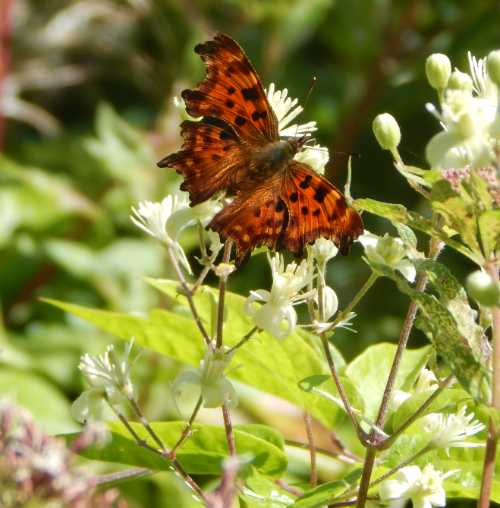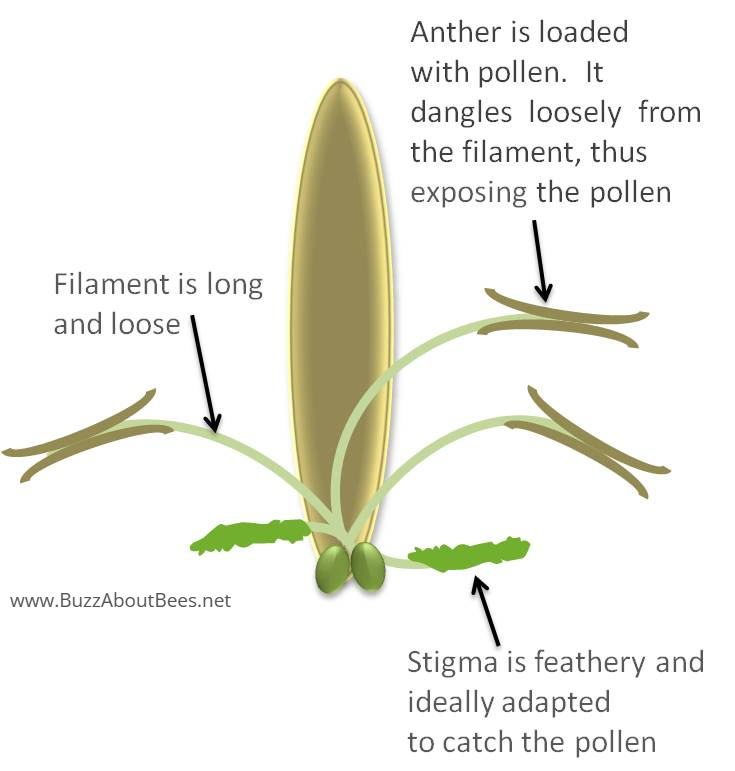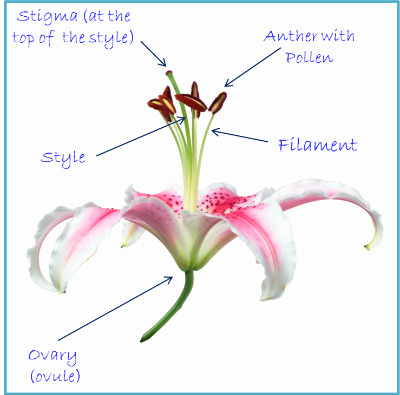Bee Pollination
Updated: December 2022
Around a third of the food we eat is estimated to be dependent on insect and bee
pollination. In providing this pollination service, bees literally
contribute billions in cash to the world economy.
This article is about the cash value contribution of bees to pollination services, and the importance of different types of bees species (e.g. leafcutter bees, mason bees, honey bees and bumble bees) to pollination and the food chain.
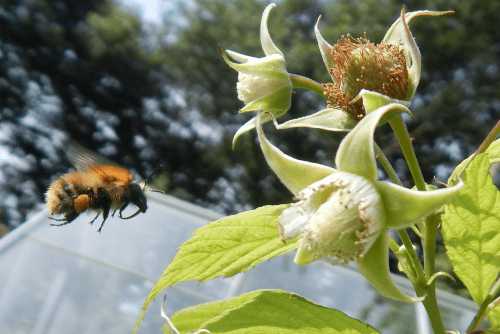 Common carder bumble bee flying toward raspberry flowers.
Common carder bumble bee flying toward raspberry flowers.How Much Is Bee Pollination Worth To The Global Economy?
Financial estimates of the contribution of bee pollination to the global economy vary, however, here are a number of estimations from a variety of studies and resources.
1. In October 2010, the United Nations published a report1, in which they placed a value on insect pollination at £134 billion (EUR 153bn) globally, which they state is about 9.5% of
the total value of human food production worldwide.
2. The leading categories of insect-pollinated crops are vegetables and fruit, making around EUR 50 billion each, followed by edible petroleum crops, stimulants, nuts and spices2.
3. Of
all animal pollinators, bees are the most important group overall. Bees visit more than 90% of the leading 107
global crop types3.
The activity of farming these crops also provides employment and income for millions of people worldwide3.
4. In 2000, the value of crops pollinated by bees was estimated at US$ 14.6 billion in the USA alone1.
5. One tonne of non-pollinator dependent crops is valued at about EUR 151, whereas crops dependent on pollinators are valued at EUR 761 on average per tonne2.
In other words, the value of one tonne of pollinator-dependent crop is approximately five times higher than one of those crop categories that do not depend on insects1.
6. Goulson4 asserts the contribution of bees is vast, although estimates vary:
- US $1.6 - $40 billion per annum
- Canada: C$1.2 billion per annum
- European Union (EU): Euros 5 billion per annum (1989 figures), of which 4.2 billion was ascribed to honey bees
- Australia: Aus$156 million per annum
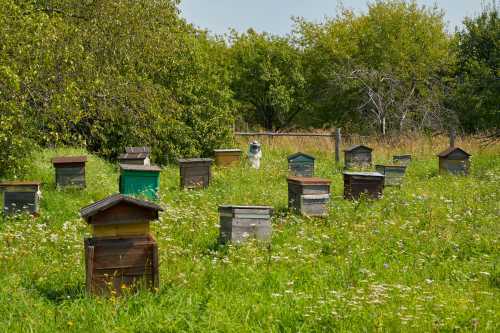 An apiary
An apiary7. In the USA alone, pollination results in USD 16 billion annually with USD 12 billion attributable solely to the accessibility of honey bees (Khalifa et al2 citing Calderone et al (2009)5 and Rader et al (2016)6).
Which food crops do bees pollinate?
Many of the most widely grown and valuable cash crops, such as cocoa, almonds and coffee, are primarily bee pollinated3.
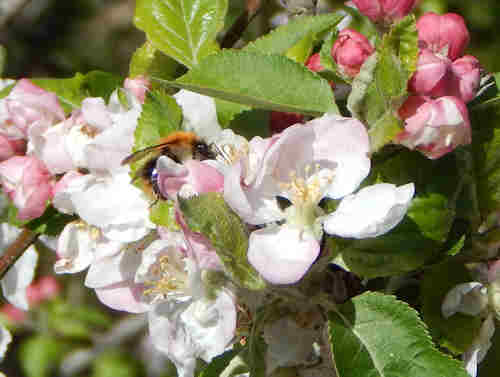 A carder bumble bee foraging on an apple blossom flower. As she does so, she will enable pollination to occur by carrying pollen grains on her furry body from the male (stamen) to the female (carpel) parts of flowers, ultimately resulting in fruit (apples) on the tree.
A carder bumble bee foraging on an apple blossom flower. As she does so, she will enable pollination to occur by carrying pollen grains on her furry body from the male (stamen) to the female (carpel) parts of flowers, ultimately resulting in fruit (apples) on the tree.
Many different food crops are pollinated by bees, along with other insect pollinators. The list includes:
- various vegetables from the pea and bean family
- squashes, curcubits, corgettes
- a variety of nuts such as almonds (for which the honey bee is especially important)
- berry fruits, for example, blueberries to cranberries, strawberries, raspberries and blackberries and more
- stone fruits, such as cherries, plums, apricots
- fruits with pips, such as apples and pears
- food crops eaten by livestock, such as alfalfa.
Bee pollination helps feed birds and animals
Many plants are pollinated by bees and other insects, which in turn create foods for other creatures in the form of seeds, hips, nuts and berries, as well as the plant itself.
Chestnuts, for example, are enjoyed by deer; holly berries are snaffled hungrily by birds in winter. These fruits are borne on trees that first have their flowers pollinated by insects like bees.
Facts about bees and crop pollination
1. The Food and Agriculture Organisation of the United Nations (FAO) estimates that out of some 100 crop species which provide 90% of food worldwide, 71 of these are bee-pollinated1.
2. Loss of bee-pollinated food crops would impact human diets and would require changes to land and agricultural management practices in order to compensate for the crop shortfall3.
3. In Europe alone, 4,000 vegetable varieties exist thanks to pollination by bees1.
4. Some commercial plants, such as almonds or blueberries, do not produce any fruit without pollinators1.
5. Improved pollination can reduce the time between crop flowering and fruit set, reducing the risk of exposing fruit to pests, disease, bad weather, agro-chemicals and saving usage of water1.
6. Research suggests pollinator-dependent crops are important for balanced human diets (and by extension, for human health), since they are often a key source of many micronutrients, including vitamins A and C, calcium, fluoride and folic acid3.
7. Pollinators ensure both a reliable and diverse seed, nut and fruit supply. A number of wild plants rely on pollinators, thus pollinators contribute to biodiversity and the ecosystem3.
8. Research suggests there are positive links between pollinators and yields in both small- and large-holding crop systems worldwide3.
9. Pollinator-dependent plants contribute directly to medicines, biofuels, fibres, construction materials, musical instruments, arts, crafts and recreation activities3.
How do bees pollinate flowers?
Bees pollinate flowers by carrying pollen on their bodies from the male part (the ‘stamen’) of one flower to the female part (the ‘carpel’) of another flower.
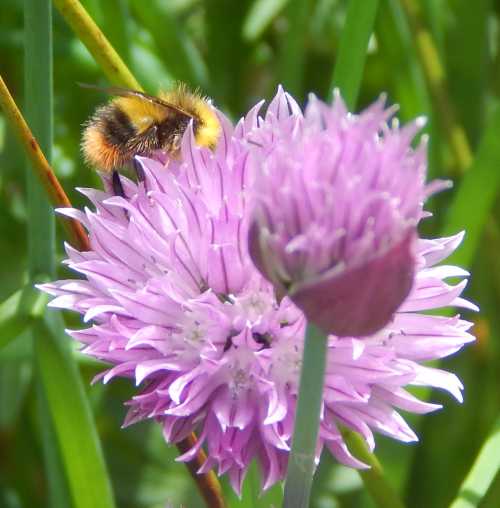 Early bumble bee, Bombus pratorum on wild chives
Early bumble bee, Bombus pratorum on wild chives
Read more about the plant pollination process.
Which bees pollinate the most flowers? 10 Facts
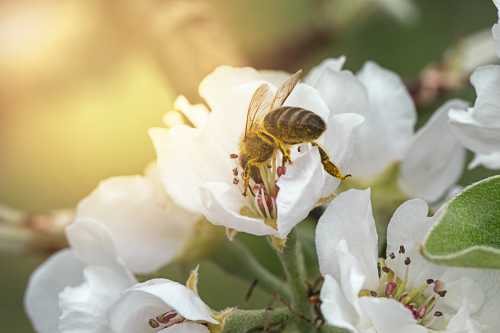 Globally, the Honey Bee is recognized as the most commercially valuable pollinator.
Globally, the Honey Bee is recognized as the most commercially valuable pollinator.
1. Globally, around 12 bee species are commonly used for crop pollination commercially. These include the Western Honey Bee (Apis mellifera), the Eastern Honey Bee (Apis cerana), plus some bumble bee, stingless and solitary species2.
2. Honey bees are the most economically valuable pollinators for crop monocultures worldwide1.
Yields of certain fruit, seed and nut crops decrease by more than 90% without the aid of these pollinators. Honey bees also contribute value from production of hive products: honey, wax, propolis and royal jelly1.
3. Some species are able to buzz pollinate.
4. Other bee species are specialists, selecting to visit only a narrow range of plant types. Species with such foraging habits may be crucial to the survival of the plant on which it specializes.
5. Each season, honey bees, local bees, and flies pollinate 48 crops of the world’s most valuable commodities, contributing significantly to the global economy2.
6. The Western honey bee (Apis mellifera) is the main species responsible for bee pollination worldwide and meets, for instance, 34% of pollination service demands in the United Kingdom2.
7. Honey bees are vital for some food crops, such as almonds since they are able to venture out in cooler temperatures when almond flowers need to be pollinated.
8. However, many wild bees of different species are increasingly being recognized for their value as pollinators.
Fo example, in comparison to wild bees alone, Greenleaf and Kremen observed that interactions between wild bees and honey bees doubled pollination rates and enhanced the prevalence of hybrid sunflowers by five-fold2.
9. It's unlikely that all wild bee species are equally valuable in terms of their pollination service.
It's worth remembering that the 'bee' group of insects includes species such as the waspy-looking cleptoparasite Nomad bee species pictured below.
Whilst they may provide some service, it is difficult to imagine they would be on a par with the bumble bee, honey bee, or solitary species such as leafcutters and mason bees.
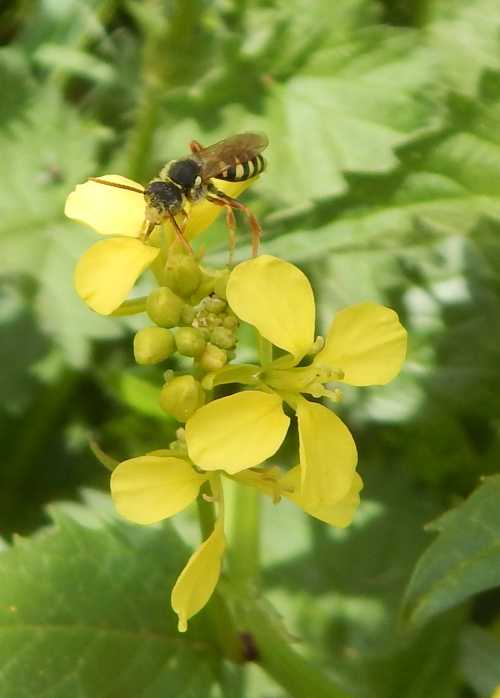 Above - a nomad bee species
Above - a nomad bee species
10. It is impossible to accurately calculate which bees pollinate the most flowers overall (including wild and garden flowers, trees, hedgerows and shrubs), because it relies on many factors, such as the presence of multiple wild species and the suitability of local habitat.
Likewise, the availability of honey bees could rely on the presence of wild colonies, or, for example, the involvement of commercial colonies (colonies hired out by beekeepers to farmers wanting to purchase crop pollination services).
Why are honey bees mostly used for pollination in commercial crop growing?
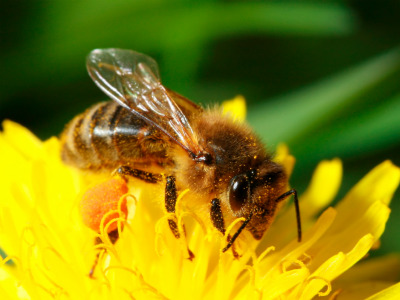 Honey bee
Honey bee
Primarily, honey bees have been used in crop pollination, because humans have been keeping bees for many years. This has meant it is possible to transport colonies from one location to another.
However, increasingly, ways are being found to harness pollination from other bees species.
Pollination and wild bees
The Megachilidae Family
The Megachilidae bee family in general, includes a number of efficient pollinators.
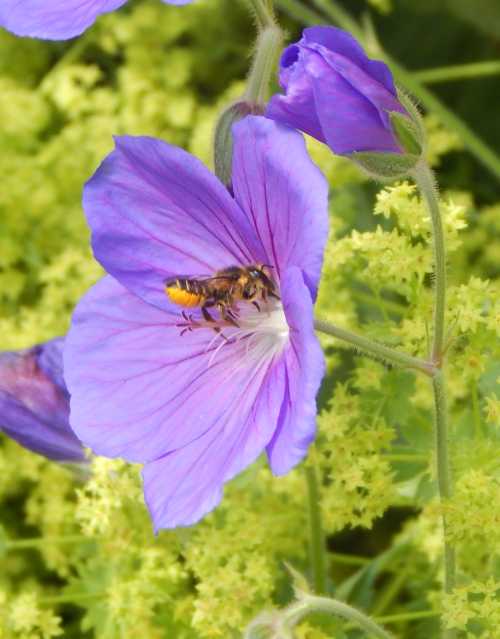 Leafcutter bees are very efficient pollinators of flowers and foods.
Leafcutter bees are very efficient pollinators of flowers and foods.For example, this family includes mason bees and leafcutter bees.
Increasingly, some members of this bee family are used in commercial
pollination, such as Alfalfa leafcutter bees (Megachile rotundata), and Osmia lignaria (the "Orchard Mason Bee" or "Blue Orchard Bee"), which is especially sold for use in orchard crop pollination.
According to the U. S. Department of Agriculture researchers, only 250 female blue orchard bees (Osmia lignaria) are required to pollinate an acre of apples - a service equivalent to one or two honey bees hives, each containing 15,000 to 20,000 workers (Bosch and Kemp, 2001).
It's possible to farm in harmony with
nature, and attract these bees to the land, which is better for crop yields.
Bumble Bees
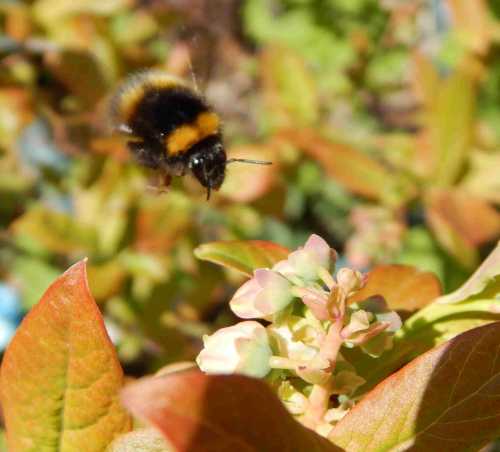 Bumble bees love foraging on blueberries. They simultaneously pollinate the flowers which ensures the bush produces more fruits.
Bumble bees love foraging on blueberries. They simultaneously pollinate the flowers which ensures the bush produces more fruits.Bumble bees are also used for commercial pollination of crops, although
farmers can attract them naturally to their land by using wildlife
friendly farming techniques, such as allowing areas of meadow,
maintaining pollinator margins and so on.
Some plants require ‘buzz pollination’
– this is especially important for crops such as tomatoes.
References
1. UNEP 2010 - UNEP Emerging Issues: Global Honey Bee Colony Disorder and Other Threats to Insect Pollinators
2. Khalifa SAM, Elshafiey EH, Shetaia AA, El-Wahed AAA, Algethami AF, Musharraf SG, AlAjmi MF, Zhao C, Masry SHD, Abdel-Daim MM, Halabi MF, Kai G, Al Naggar Y, Bishr M, Diab MAM, El-Seedi HR. Overview of Bee Pollination and Its Economic Value for Crop Production. Insects. 2021 Jul 31;12(8):688. doi: 10.3390/insects12080688. PMID: 34442255; PMCID: PMC8396518.
3. Potts SG, Imperatriz-Fonseca V, Ngo HT, Aizen MA, Biesmeijer JC, Breeze TD, Dicks LV, Garibaldi LA, Hill R, Settele J, Vanbergen AJ. Safeguarding pollinators and their values to human well-being. Nature. 2016 Dec 8;540(7632):220-229. doi: 10.1038/nature20588. Epub 2016 Nov 28. PMID: 27894123.
4. Bumblebees Behaviour and Ecology, by Professor Dave Goulson, Oxford University Press, 2003.
5. Calderone N.W. Insect pollinated crops, insect pollinators and US agriculture: Trend analysis of aggregate data for the period 1992–2009. PLoS ONE. 2012;7:e37235. doi: 10.1371/journal.pone.0037235.
6. Rader R., Bartomeus I., Garibaldi L.A., Garratt M.P.D., Howlett B.G., Winfree R., Cunningham S.A., Mayfield M.M., Arthur A.D., Andersson G.K.S., et al. Non-bee insects are important contributors to global crop pollination. Proc. Natl. Acad. Sci. USA. 2016;113:146–151. doi: 10.1073/pnas.1517092112.
If you found this page helpful or interesting, I'd really be grateful if you would share it with others - if not this page, perhaps another, such as Gardening For Bees.
Thank you so much :) .
